Total Solar Eclipse in Spain - August 2, 2027
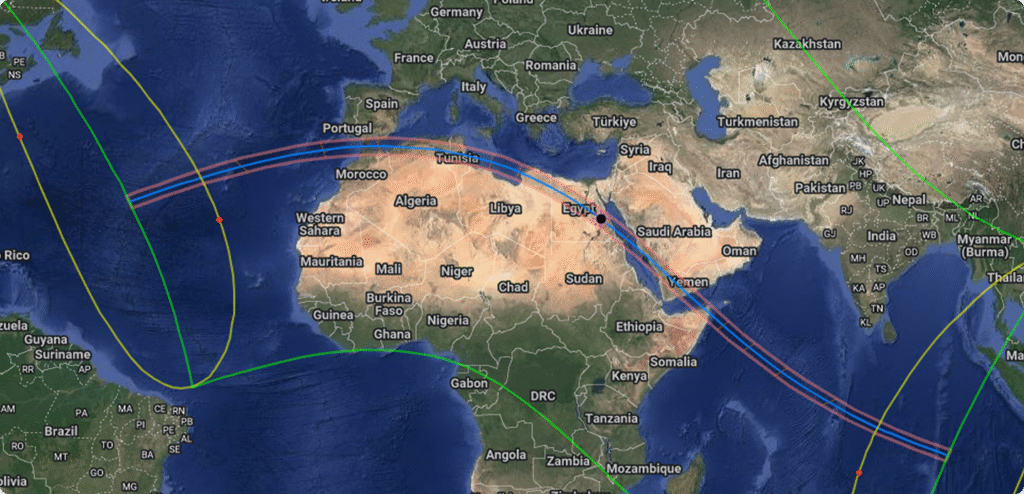
Total Solar Eclipse of 2027 – The Eclipse of the Century
On August 2, 2027, Spain will once again witness a spectacular astronomical event: a total solar eclipse. This particular eclipse is remarkable because it will cover large, densely populated areas during the summer season in the northern hemisphere, and it coincides with regions that historically have very low cloud cover during the month of the solar eclipse. Adding to its significance, this will be the longest land-visible total solar eclipse of the 21st century and the longest until July 2114, giving it the title of “Eclipse of the Century.”
The 2027 solar eclipse begins over the subtropical mid-Atlantic Ocean, in a zone generally clear of hurricane activity. The path of the lunar shadow narrowly misses Madeira and Porto Santo, making its first landfall in Spain and Morocco just minutes later. From there, the shadow continues eastward for more than 4,000 km, crossing the Mediterranean coastline, moving into Libya, Egypt, and then toward the Indian Ocean, where it finally concludes near the remote atoll of Diego Garcia.
Few eclipses offer such favorable conditions for cloud-free viewing. The path of the 2027 solar eclipse across North Africa is especially promising, with satellite records indicating extremely low cloud cover over Libya and Egypt. Although Morocco and parts of Spain face occasional weather challenges, climatology shows that summer skies in these regions are generally clear. In fact, certain stretches of Libya and western Egypt have recorded zero cloud cover on August 2nd for more than two decades. Observers in Spain and Northwest Africa can also expect excellent chances of visibility
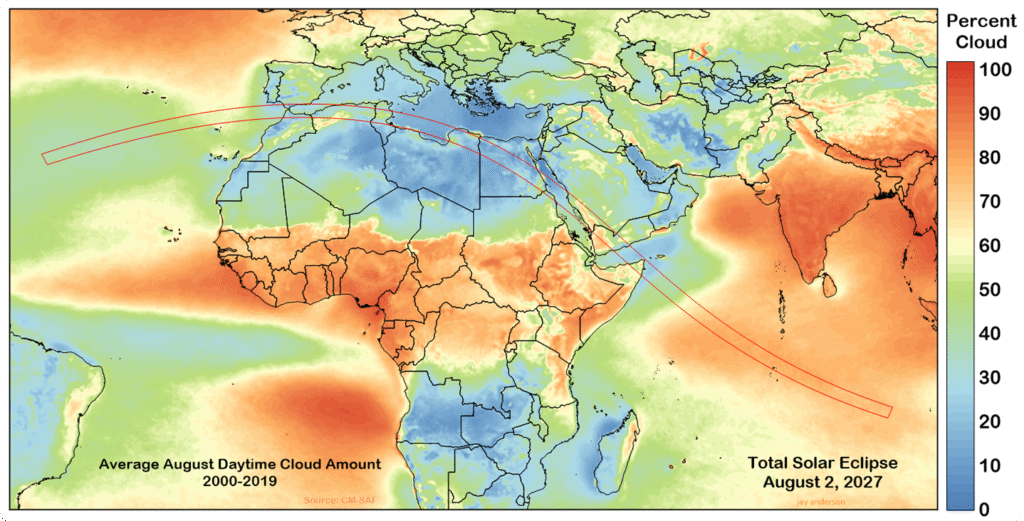
Although Morocco, Algeria, and Tunisia can present occasional weather challenges, the majority of the eclipse path follows the northern edge of the Sahara Desert, where the climate takes on the defining characteristics of this vast sand sea. Conditions here are typically hot, dry, bright, and dusty—precisely the kind of environment in which an eclipse can be observed at its best.
Historical records show that along certain stretches of the eclipse path, particularly in Libya and western Egypt, there has not been a single instance of cloud cover during early August on eclipse day over the past 23 years.
While Spain and parts of Northwest Africa do experience cloudy periods, such occurrences are relatively infrequent during this season, leaving observers with excellent odds of clear skies. In fact, throughout much of Libya and Egypt, cloud is virtually absent in the summer months, and it is only once the path extends to Luxor that even a minimal increase in cloud fraction becomes apparent.
At the time of the event, the eclipse will occur in the late morning in Spain and around 1:00 pm in Egypt. The Sun will be high in the sky, making conditions particularly favorable for observation. Depending on location, totality will last between 2 minutes and a remarkable 6 minutes and 24 seconds, with the longest duration near Luxor, Egypt.
Total Solar Eclipse 2027 in Spain
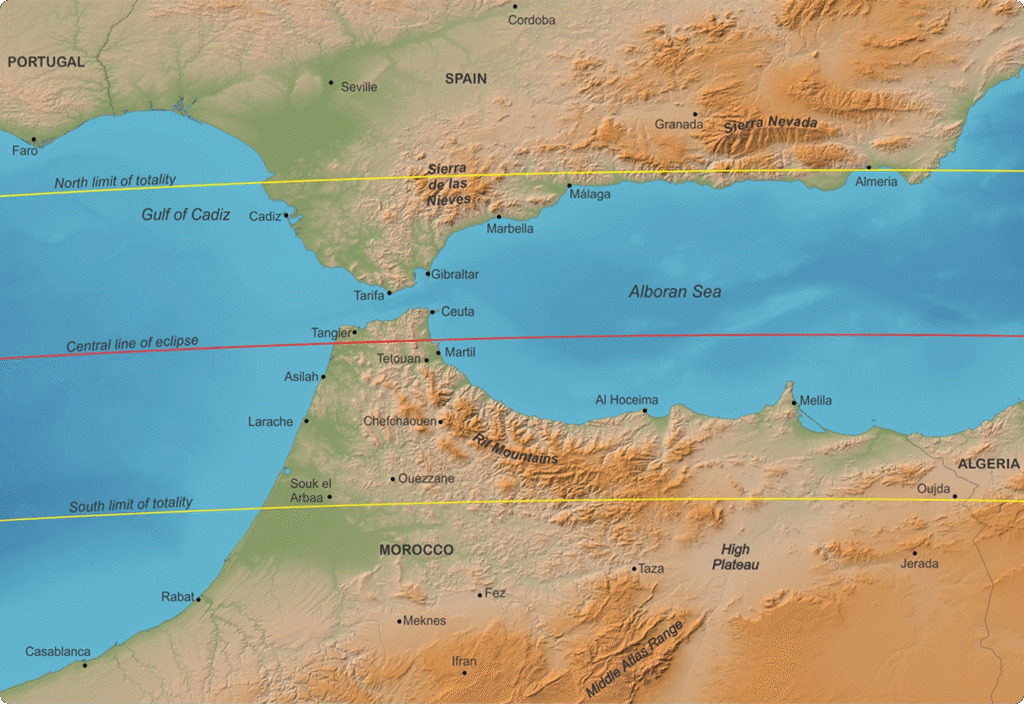
Path of the 2027 solar eclipse in Spain
The path of totality of the 2027 solar eclipse will cut across southern Spain, bringing complete darkness to much of the Andalusian coast.
Cities and towns such as Málaga, Marbella, Tarifa, and Cádiz will all experience a total solar eclipse. Inland, the national parks of Los Alcornocales, Sierra de Grazalema, and Sierra de las Nieves will also fall within the eclipse path.
The further south you travel, the longer the total phase of the eclipse will last.
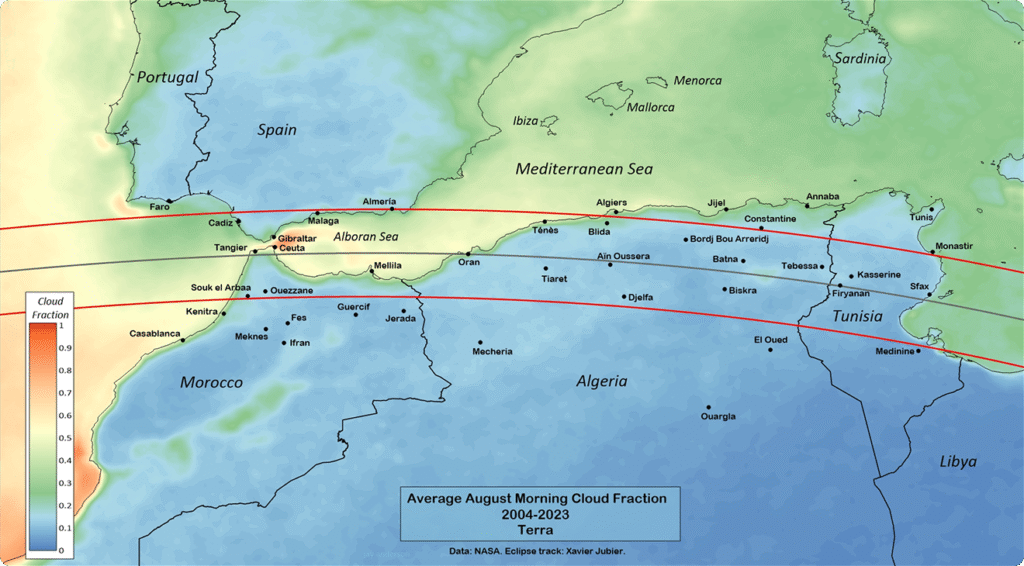
Clouds and climate
The Atlantic Ocean plays a major role in shaping weather conditions along Spain’s southern coast. Morning fog and marine cloud layers can occur near the Atlantic coastline, but these usually dissipate quickly and rarely extend beyond Tarifa into the Mediterranean. Marbella and the Alboran coast typically benefit from clear skies, while Cádiz experiences somewhat more variability due to higher-altitude clouds. Satellite data shows that inland areas in southern Spain are some of the most reliable eclipse-viewing locations, with average cloud coverage below 15%.
Traffic and Travel in Spain During the 2027 Solar Eclipse
Planning to witness the 2027 solar eclipse in Spain? Be prepared—with the total eclipse visible in a narrow strip along the south coast of Spain, roads are expected to be heavily congested, Parking will also pose a major challenge. Many popular spots may lack designated parking space, leading drivers to use roadside shoulders or shoulders—as makeshift parking zones. This puts further strain on traffic flow and can create bottlenecks, making even short trips cumbersome.

The excellent news however is this: Unlike the 2026 eclipse, where totality occurred only a few degrees above the horizon, the 2027 event will unfold with the Sun positioned much higher in the sky. In addition, climatological records suggest that most of the region should enjoy clear conditions with minimal cloud cover, meaning that virtually any location within the eclipse path can provide an excellent viewing experience.
For those who already live or are vacationing inside the path of totality, there is little need to travel extensively—unless the goal is to move farther south in order to enjoy a slightly longer duration of totality.
For travelers coming from outside the eclipse zone, there will be plenty of possible destinations to choose from along the coast and the inland natural parks.
However, because public transportation options to inland natural parks are limited or nonexistent, travelling by car will be the most practical way to reach them.
1. Arrive Early and Settle In
To avoid post-eclipse chaos, travel experts advise arriving well before totality—even considering arriving in the early morning or even spending the previous night in or close to your viewing town. This minimizes the pressure of last-minute arrivals and offers a smoother experience.

2. Expect traffic jams so be patient and prepared
Once the eclipse ends, large numbers of people, especially those who observed the event from inland areas, will attempt to return to towns and coastal resorts at the same time. Since most natural parks in the region offer very limited lodging, nearly everyone will be on the road. Traffic is therefore expected to be extremely heavy and in some cases nearly impassable.
Travelers should plan for long delays, carry sufficient water and food, and exercise patience throughout the day.
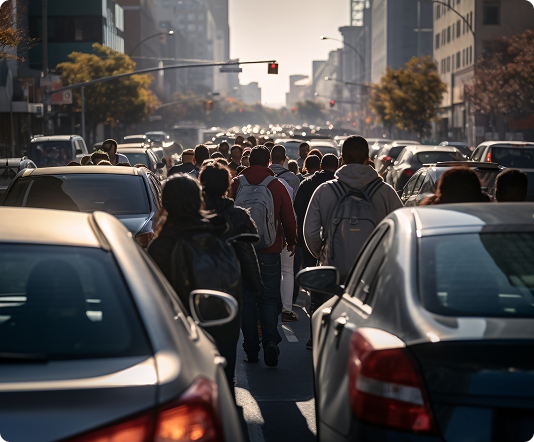
Best places to watch the 2027 solar eclipse in spain
| City | Autonomous Community | Start of the Eclipse | Start Total Eclipse | End Total Eclipse | Maximum Totality | Sun Altitude at Maximum | Duration Totality |
|---|---|---|---|---|---|---|---|
| Peñíscola | Valencia | 19:36:47 | 20:30:29 | 20:32:08 | 20:31:19 | 04.4° | 1m 39.3s |
| Valencia | Valencia | 19:38:20 | 20:30:29 | 20:32:08 | 20:31:19 | 04.4° | 1m 39.3s |
| Alcobendas | Madrid | 19:36:28 | 20:30:29 | 20:32:08 | 20:31:19 | 04.4° | 1m 39.3s |
| A Coruña | Galicia | 19:30:52 | 20:30:29 | 20:32:08 | 20:31:19 | 04.4° | 1m 39.3s |
| Ferrol | Galicia | 19:30:40 | 20:30:29 | 20:32:08 | 20:31:19 | 04.4° | 1m 39.3s |
| Ribadeo | Galicia | 19:30:47 | 20:30:29 | 20:32:08 | 20:31:19 | 04.4° | 1m 39.3s |
| Lleida | Catalonia | 19:34:39 | 20:30:29 | 20:32:08 | 20:31:19 | 04.4° | 1m 39.3s |
| Tarragona | Catalonia | 19:35:29 | 20:30:29 | 20:32:08 | 20:31:19 | 04.4° | 1m 39.3s |
| Burgos | Castilla y León | 19:33:17 | 20:30:29 | 20:32:08 | 20:31:19 | 04.4° | 1m 39.3s |
| León | Castilla y León | 19:32:40 | 20:30:29 | 20:32:08 | 20:31:19 | 04.4° | 1m 39.3s |
| Lerma | Castilla y León | 19:33:51 | 20:30:29 | 20:32:08 | 20:31:19 | 04.4° | 1m 39.3s |
| Osorno | Castilla y León | 19:33:07 | 20:30:29 | 20:32:08 | 20:31:19 | 04.4° | 1m 39.3s |
| Palencia | Castilla y León | 19:33:49 | 20:30:29 | 20:32:08 | 20:31:19 | 04.4° | 1m 39.3s |
| Ponferrada | Castilla y León | 19:32:38 | 20:30:29 | 20:32:08 | 20:31:19 | 04.4° | 1m 39.3s |
| Soria | Castilla y León | 19:34:22 | 20:30:29 | 20:32:08 | 20:31:19 | 04.4° | 1m 39.3s |
| Valladolid | Castilla y León | 19:34:26 | 20:30:29 | 20:32:08 | 20:31:19 | 04.4° | 1m 39.3s |
| Guadalajara | Castile-La Mancha | 19:36:19 | 20:30:29 | 20:32:08 | 20:31:19 | 04.4° | 1m 39.3s |
| Santander | Cantabria | 19:31:18 | 20:30:29 | 20:32:08 | 20:31:19 | 04.4° | 1m 39.3s |
| Bilbao | Basque Country | 19:31:43 | 20:30:29 | 20:32:08 | 20:31:19 | 04.4° | 1m 39.3s |
| Ibiza | Balearic Islands | 19:39:11 | 20:30:29 | 20:32:08 | 20:31:19 | 04.4° | 1m 39.3s |
| Palma | Balearic Islands | 19:37:59 | 20:30:29 | 20:32:08 | 20:31:19 | 04.4° | 1m 39.3s |
| Gijón | Asturias | 19:30:58 | 20:30:29 | 20:32:08 | 20:31:19 | 04.4° | 1m 39.3s |
| Oviedo | Asturias | 19:31:15 | 20:30:29 | 20:32:08 | 20:31:19 | 04.4° | 1m 39.3s |
| Escucha | Aragón | 19:36:05 | 20:30:29 | 20:32:08 | 20:31:19 | 04.4° | 1m 39.3s |
| Jaraba | Aragón | 19:35:23 | 20:30:29 | 20:32:08 | 20:31:19 | 04.4° | 1m 39.3s |
| Teruel | Aragón | 19:36:51 | 20:30:29 | 20:32:08 | 20:31:19 | 04.4° | 1m 39.3s |
| Zaragoza | Aragón | 19:34:37 | 20:30:29 | 20:32:08 | 20:31:19 | 04.4° | 1m 39.3s |
If you know of ideal spots to watch the eclipse, please share them with others in the Discussion group below.
Please add photos, coordinates, anything you like.

